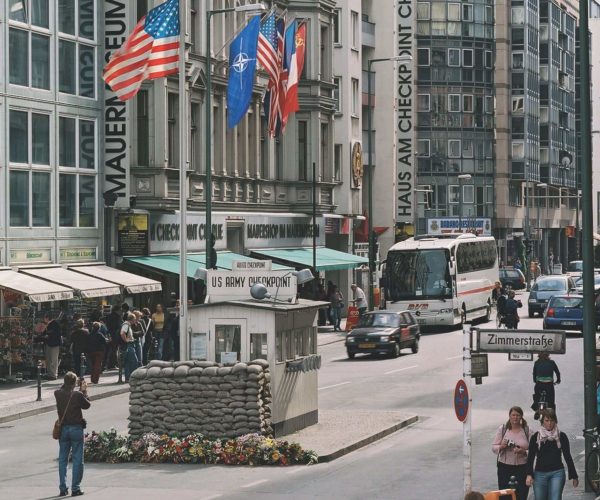The Berlin Wall is a symbol of the Cold War and its division not just only of West and East Germany but also of Western and Eastern Europe and plays, therefore, an important role in modern German and European history.
The Berlin Wall is also a must-see on our Best of Berlin School Trip. Read on if you’d like to discover some of the facts and history of the Berlin Wall.
After the Second World War ended in 1945, Germany was divided by the allies into four occupation zones: The Americans, British and French made up the West, which became later the Federal Republic of Germany. The Soviets made up the East, which became the German Democratic Republic.
Not only the country but also its capital Berlin was divided: while the Americans, British and French occupied West Berlin, the East was occupied by the Soviets.
The tensions between West and East, which can also be traced back to the different economic systems and ideologies, began early. Already in 1948/49, during the blockade of West Berlin, the differences could not be overlooked.
Especially in the East, people were dissatisfied and left their country for the West. Until May 1952, all Berliners could move around the then two countries freely. But then, the GDR decided to close their border officially and create a Spear Zone. But, people could still pass the border, for example for work.
In June 1961, as more and more people left the GDR, many of them were skilled workers and intellectuals, the rumours of a possible closure of the border intensified. However, Walter Ulbricht, a politician of the GDR, promised that no one wanted to build a wall.
Regardless of that, the until then secret preparations to finally close the border began in the late evening of 12 August 1961. On 13 August 1961, the GDR started to build the Berlin Wall. What was officially intended to be an “antifascist bulwark” was supposed to prevent its population from escaping. During that night and the following day, many people tried to flee to the West at the risk of their own lives. From then on, a concrete wall with a total length of 167.8 km encircled West Berlin and separated friends and families.
But while the wall stood, crossing was still possible for some, three crossing points made this possible. The main one of them was Checkpoint Charlie, which is still one of the sights of Berlin today.
For over 38 years the Berlin Wall separated the West and the East, until on 09 November 1989, because of many protests and economic dissatisfaction, a new travel law in the GDR was announced – the border was therefore open, the wall was down!
During these years, from 1949, when the GDR was founded, and 1989, when the wall fell, around 3.8 million people fled from East Germany.
Before the wall was built, around 2.8 million people migrated to West Germany. In total, more than 100,000 people tried to cross the inner-German border while over 600 of them were killed or died during their attempts. At least 140 of them were killed or died at the Berlin Wall trying to escape.
Nevertheless, it was not until 03 October 1990 that the two countries united. Therefore, in Germany, you celebrate the “German Unification Day” on 03 October.
Today, there are still many traces and pieces of the wall around Berlin as well as many memorial sites remembering and teaching about that period of German history. One of the most famous sites is the East Site Gallery, a 1.3 km long piece of the Berlin Wall which became an open-air gallery with numerous paintings of more that hundred international artists on it.

To check out more of the History of the Berlin Wall, please click VISITBERLIN.DE or HISTORY.COM.
Maybe you want to visit Berlin with your class, if so, check out our Berlin school trip
Prepare for it with more exciting information reading on the following blog: Things to do and see on a school trip to Berlin
Contact Us



